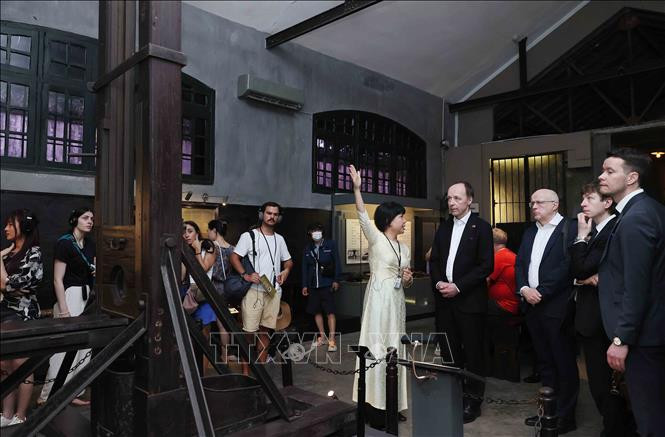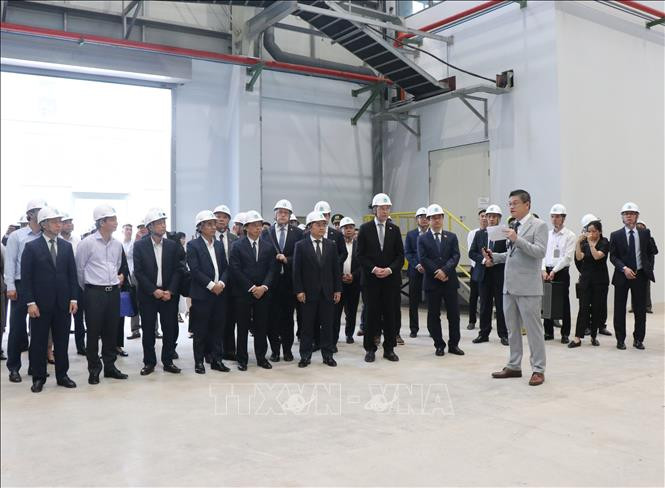On March 26, the President of the Finnish Parliament and his delegation visited the Temple of Literature - Quoc Tu Giam; Hoa Lo Prison; attended the ceremony to certify the completion of the Thang Long - Bac Ninh Waste-to-Energy Plant Project...

Visiting the special national relic of Van Mieu - Quoc Tu Giam, National Assembly Chairman Jussi Halla-aho and the delegation were introduced to the history of the formation and development of Vietnam's first university, a place closely associated with the nation's tradition of studiousness, a place where the quintessence of learning of ancient Dai Viet and present-day Vietnam converge.
The President of the Finnish Parliament and the delegation visited ancient architectural works such as Dai Trung Gate, Khue Van Cac, Dai Thanh Palace, the doctoral stele garden and the Van The Su Bieu Chu Van An; learning about the place that preserves and honors Confucianism, preserves and best demonstrates the outstanding values of Vietnamese culture.
Here, the President of the Finnish Parliament signed the golden book of memories. The leaders of the Center for Cultural and Scientific Activities of the Temple of Literature - Imperial Academy presented the President of the Finnish Parliament and the delegation with the book "Temple of Literature - Imperial Academy Thang Long".
The Temple of Literature - Quoc Tu Giam was built in 1070 (the second year of Than Vu under the reign of Ly Thanh Tong); it is considered a symbol of knowledge and Vietnamese education. With its ancient architecture and unique humanistic values, the Temple of Literature - Quoc Tu Giam is the link between the history of Hanoi past and present, contributing to enriching the cultural treasure of the nation. In recent years, the Temple of Literature - Quoc Tu Giam has become an attractive cultural destination, attracting domestic and foreign tourists.

In Hanoi, on the same day, National Assembly Chairman Jussi Halla-aho and his delegation visited and learned about Hoa Lo Prison Relic with many valuable documents and artifacts, learning more about the heroic and indomitable activities of Vietnamese revolutionaries.
Hoa Lo Prison (now the historical relic of Hoa Lo Prison) was one of the largest prisons of the French colonialists in Indochina, built in 1896 in Phu Khanh village, Vinh Xuong commune, Tho Xuong district, Hanoi (now 1 Hoa Lo street, Hanoi). This was the place where thousands of Vietnamese patriots were detained. Imprisoned by the French, despite having to endure harsh living conditions and torture, the revolutionary soldiers still kept their patriotism, were indomitable, resilient, overcame difficulties, and turned the prison into a revolutionary school.
Currently, Hoa Lo Prison Relic has become a "red address", a place to educate patriotism and revolutionary traditions to all classes of people, especially the young generation of the capital; a place that attracts many domestic and international visitors to visit, research and study.
On the same day, Speaker of the Finnish Parliament Jussi Halla-aho and the delegation visited and worked at Tan Thoi Dai School (Le Trong Tan Street, Ha Dong District, Hanoi). This is the first primary school in Hanoi to use all Finnish educational methods, typically the "Fun Learning" method. The school's curriculum was developed by leading Finnish and Vietnamese experts based on the new program of the Ministry of Education and Training, integrated into 6 areas.
On the afternoon of March 26, the President of the Finnish Parliament and the delegation visited and attended the opening ceremony of the new Consular Office of the Finnish Embassy in Hanoi.

On the same morning, President of the Finnish Parliament Jussi Halla-aho and the delegation attended the ceremony to certify the completion of the Thang Long - Bac Ninh Waste-to-Energy Plant Project in Dong Sai village, Phu Lang commune, Que Vo town, Bac Ninh province (supported, built and operated using Finnish technology). Secretary of the Bac Ninh Provincial Party Committee Nguyen Anh Tuan received the delegation.
Witnessing the Project Completion Certification Ceremony, the Speaker of the Finnish Parliament said that after more than 50 years of establishing diplomatic relations, the two countries have shifted from development aid to development cooperation, promoting trade cooperation on the basis of mutual benefit. This project is one of the evidences of cooperation, contributing to improving the environment, mitigating climate change, towards the goal of green and sustainable development that the two countries are aiming for.
Vice Chairman of Bac Ninh Provincial People's Committee Dao Quang Khai expressed his honor that Mr. Jussi Halla-aho and the delegation took the time to attend the event, demonstrating the interest and effective support of the Finnish Government for environmental protection in Vietnam in general and Bac Ninh province in particular; further enhancing the good cooperative relationship between the two countries.
Bac Ninh currently has 16 industrial parks under development and 12 industrial parks in operation with nearly 2,000 registered investment enterprises and about 300,000 workers. Every day, the province generates about 1,100 tons of domestic waste (not to mention hundreds of tons of industrial waste). This amount increases about 7 - 10% per year. Currently, the whole province has 4 waste-to-energy plants, with a total capacity of about 1,500 tons/day. To date, 1 plant has officially come into operation, 2 plants are in trial operation.
The Thang Long - Bac Ninh Waste-to-Energy Plant project has a total area of about 5 hectares, a processing capacity of 500 tons/day, a power generation capacity of 11MW, and a total investment of about 1,400 billion VND (equivalent to 58.3 million USD). The project uses advanced equipment and technology, imported directly from Finland, especially the waste pre-treatment line and the fully fluidized bed incinerator, which are used for the first time in Vietnam. This will be the "last piece" of Bac Ninh province in completely handling daily household waste.
After the Waste-to-Energy Plant comes into operation, Bac Ninh will become the first province in the country to treat all daily household waste using the world's advanced, high-tech waste-to-energy technology.
On this occasion, the President of the Finnish Parliament and the delegation visited the factory and listened to an introduction to the operation and waste treatment process at the factory.